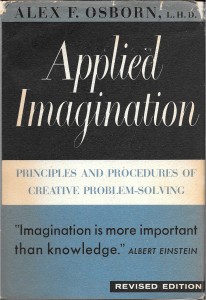The one sentence summary
Brainstorming is the best way to generate lots of fertile ideas.
WHAT THE BOOK SAYS 
- This is the classic 1953 book about the principles and procedures of creative problem solving, written by one of the founders of the BBDO advertising agency (Batten Barton Durstine Osborn).
- Here he coins the concepts of brainstorming and group ideation for the first time. (He recommends 12 people as the optimum number).
- The system is based on four principles:
- Criticism is ruled out. Adverse judgement of ideas must be withheld till later.
- Freewheeling is welcomed. The wilder the idea, the better.
- Quantity is wanted. The greater the number of ideas, the more the likelihood of winners.
- Combination and improvement are sought. Build on the ideas of others.
- Our thinking mind is mainly twofold:
- A judicial mind analyses, compares and chooses
- A creative mind visualises, foresees, and generates ideas
- When judgement is served too early, it stifles creativity, so groups adopting the second approach generate 10 times as many ideas.
- Creative imagination hunts out interesting stuff, and works out how to change what is found. The process needs to run from orientation, preparation, and analysis to ideation, incubation, synthesis and
- The brief or subject of each brainstorm needs to be specific, thus preventing vague ideas that won’t work.
WHAT’S GOOD ABOUT IT
- When you participate in a brainstorm, don’t drive with the brakes on.
- Useful questions to ask include:
- “This is next to what?”
- “What does this go with?”
- “What happens before or after?”
- “Smaller or larger?”
- “What’s this like?”
- Adapt? Modify? Magnify? Minify? Substitute? Rearrange? Reverse? Combine?
“Imagination is more important than knowledge.” Albert Einstein
“A problem well stated is half solved.” John Dewey
WHAT YOU HAVE TO WATCH
- It’s 65 years old, so you need to aim off for that. There are some hilarious anachronisms such as “Several organizations have found it helpful to include females on each brainstorm panel.”
- Subsequent academic studies have claimed that brainstorming generates fewer ideas than individuals working on their own and then pooling their ideas. The author himself admits that only 10% of the ideas will be usable.
